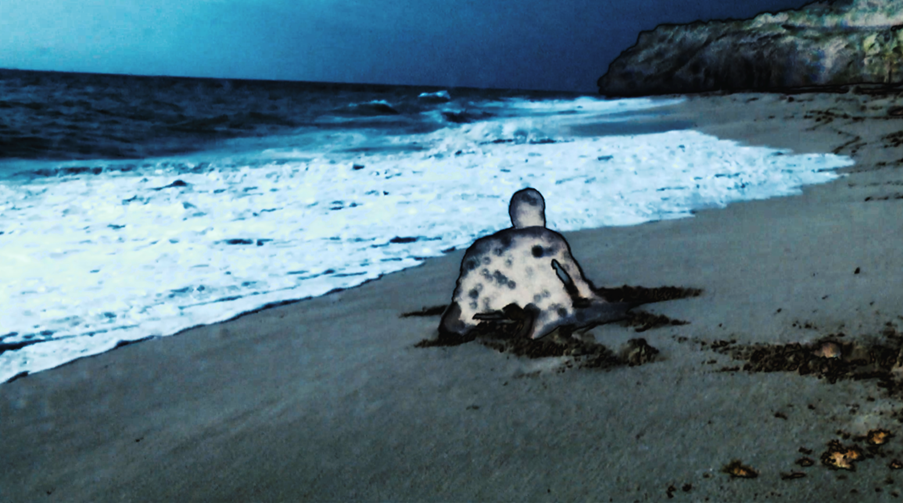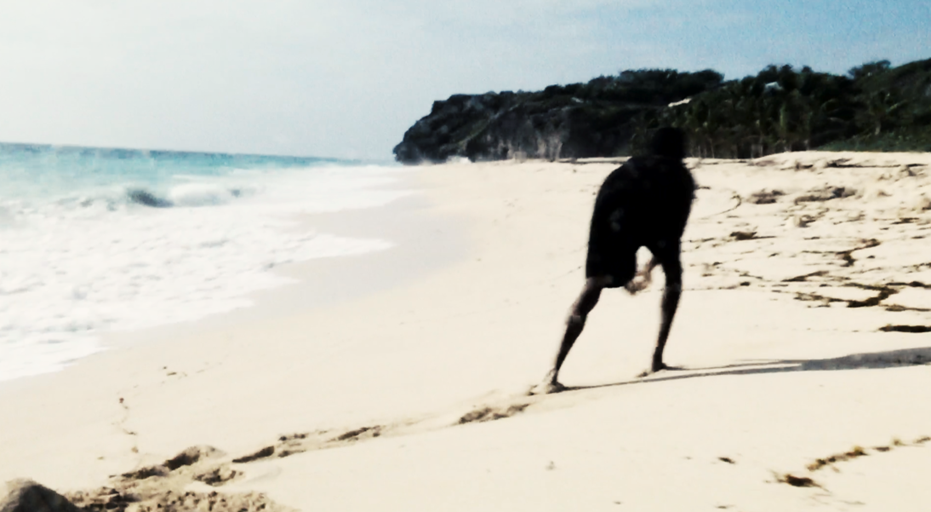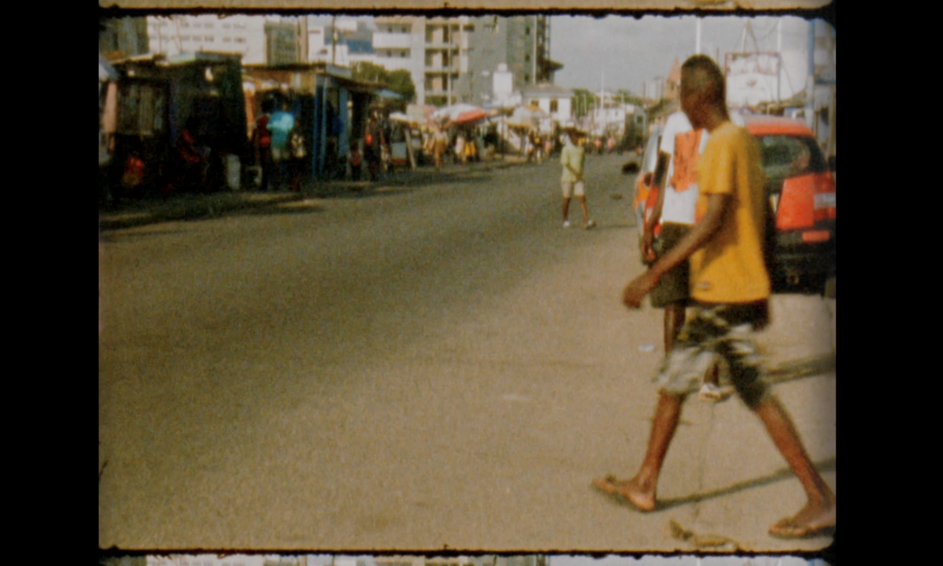
BLACK LENS: MIRO ALLEYNE-MCCARTHY & SAMUEL ADJAYE
Three young artists interview one another about their craft.
InterviewsThe conversation
Visual artist, filmmaker and poet Miro Alleyne-McCarthy and artist and filmmaker Samuel Adjaye sit down to discuss process, place and inspiration, joined by graphic communicator and photographer, Elsa Farmer (El.Nafar) as part of the Future Legacies Black Lens interview series.
Sam Adjaye: Hello, my name is Samuel Adjaye and I’m here with Miro, the God himself. What do you want to be called Miro?
Miro Alleyne-McCarthy: Just Miro. Miro Alleyne-McCarthy. If you have to box me in, you can use the artist’s box. I think today the box is an artist/filmmaker, and we’re going to talk about that, about my film Shattered Tides and my friend Sam’s film.

SA: We’re talking about ‘Akwaaba’, a film that I shot in Ghana in 2022. My baby. We’re talking about films today.
MAM: And films are babies. Shattered Tides was shot in Barbados, December 2022. When did you shoot ‘Akwaaba’?
SA: October 2022 as well. Yeah, so similar time.
MAM: I remember you were finishing your final project at GUAP Magazine, then we were both going off to our home countries in a few months’ time.
SA: Yeah, going to the homeland. I went back to Ghana for the first time ever which was mad. Picture this – I’m in Ghana for the very first time ever. And I’m 22. 22 years old and my dad had never taken us back, but it wasn’t really a disconnection from the culture, it was just more from the actual physical country, like just not being able to be there.
EF: Did it feel like you were going back?
SA: No, it didn’t no. It was the first time. The whole film and the whole concept of the film is about being welcomed to somewhere that you’ve never been for the first time. And it’s the welcoming aspect that feels like you’re coming back to somewhere.
MAM: Right, and that’s the name, right?
SA: Yeah, it’s ‘Akwaaba’, which means ‘welcome’ in Twi, which is like the main language out there. Well, one of the main ones, there’s Twi and there’s Ga. But that’s different tribes and regions in Ghana, you know, and they bring their own language. It’s all shot in Super 8. Two rolls of Super 8, so six minutes’ worth of film, into three minutes of narrative.
People often ask me what kind of films I make… They kind of just feel like dreams in their own way. In their own capsules.
Miro Alleyne-McCarthy

MAM: And where were you in Ghana? What did you see?
SA: Yeah, I mean, last year I went back in 2023 and just got back this January 2024. And I’d been for three weeks and gone to more rural areas and more villages that had been untouched… it was so inspiring and just really stripped down, stripped down human living. I think that’s how the world was. It gave me an insight into actually how other people live. Bro, I’ve lived in Hackney my whole life. I needed to see that, you know? It’s so important. So yeah, that was Ghana, man… the first time I went to Ghana, went to the city, and I didn’t see any tribes or any villages. Whereas this time I’d gone back, and I’d done a much deeper dive into the rich cultures like in the north of Ghana. I went to Kumasi, which is a region north of Ghana where the kings and the queens of the Ashanti tribe come from… the main riches of West Africa come from right there. So that’s where I saw these villages, and other stuff… jungle, like, you know what I mean, jungles and everything. What about yourself? Barbados.
MAM: Barbados. So for me, I went as a child. And I think that actually played a big role in the creation of the film. Because I went as a child and I had these memories of it. Like real snapshot memories. Like the last time I was there maybe four, and I was at my grandad’s funeral. So it was a strange time because I remember at the funeral, I remember everyone was so sad, but I was like, why are we sad? He’s watching over us right now. I just remember telling my mum that and being very convinced as a child. And then I would have dreams of Barbados occasionally, but the landscape was weird. It was very hilly, and where I’m from in Barbados it’s not very hilly; it’s towards the coast. But it was very hilly, and I remember dreaming of this big tsunami, this huge water wave. I think the dream aspects played a big role in ‘Shattered Tides’. I like my films to feel dreamlike in a way.
SA: Yeah, I see that.

MAM: People often ask me what kind of films I make, and I think that is really the only thing that connects everything I’ve done so far. They kind of just feel like dreams in their own way. In their own capsules.
SA: I feel like when I take in your films, it feels like I’m being immersed in a new kind of world, a new space. And I feel like the process in which I’m watching what you’ve created, is me figuring out where I am. It’s not these clueless questions, but really these beautiful, ambiguous questions that are just like, what’s going on? What is the story that you’re trying to tell, or where does this come from? But as you describe it, in a dream-like way, it makes so much sense to me because they do feel like we’re treading in your head, in your mind, in your thought processes, when we’re watching your films.
MAM: I feel like… it deepens the personal aspect of it
SA: 100%. It’s completely internal; then you materialised it in this weird way, in this visual world.
MAM: And then it gets seen by other people.
EF: What you were saying reminds me about [artist, chess player and writer] Marcel Duchamp. It’s about the creative act and the role of the viewer… you create this work, but until you put it out to the world, that’s not the final creation. Then it becomes like this dialogue that never stops, and what people do with it will lend different perspectives. Sam, I feel like you very eloquently summarised a way that I’ve been feeling about Miro’s work but haven’t quite been able to say. Have you ever had someone reflect on your work to you that has really changed what you think about it?
SA: After screening ‘Akwaaba’ for the first time, people […] wrote a note in this book. It was just so nice to read back, to see people wanting to communicate immediately how they felt about it. I have those perspectives and thoughts immortalised now. I love the reaction, but I don’t let it influence everything… maybe subconsciously, it does.
MAM: I remember when I saw your film, I think especially, I didn’t realise until I watched it back, but it’s the moment when you’re on the beach, and it’s just your silhouette. This is what really links [our] two films for me, and then I feel like, in a way, there are moments in my film that become mirrored, which is this beautiful call and response of feedback.
SA: It’s those silhouettes; you saw what I was trying to tell with that visual language, like that style, not seeing everything but seeing shapes and figures, and you flipped it, and you did your own thing, bro.

Well, in fact, my film was like a real-life dream. It was a dream that I went and met with, experienced, and exposed myself to. Yeah, the idea of nostalgia and creating because you’re there creating memories, but it feels like it’s happening. The film feels like memories.
Sam Adjaye
EF: I’m curious, are you both into visual effects?
SA: Yeah, that was my background, animating text and graphics, 2D graphics. I’m into graphic design. That’s how it started, the passion, drawing, typography, package design, branding, there it was. And then into making motion graphics. And then from motion, it’s making film. So it’s like, I feel like I make films from a design perspective. As strange as that sounds.
EF: And what would you say Miro?
MAM: I make film. I would say I come from more of a filmic background. It’s always been the case that I’ll write something, and then it becomes an idea, and then I shoot it. But in regard to visual effects, I’ve always loved playing with colours. I derive a lot of enjoyment from doing that.
SA: I feel like you treat it as a canvas.
MAM: Yeah, I’m not precious with it
SA: We’re going to segue into a nice place.
MAM: We’re in a dream-like conversation…
SA: Well, in fact, my film was like a real-life dream. It was a dream that I went and met with, experienced, and exposed myself to. Yeah, the idea of nostalgia and creating because you’re there creating memories, but it feels like it’s happening. The film feels like memories.

MAM: It’s the format. Do you think stepping back from the footage helped you with that?
SA: Yeah.
MAM: How was your process with editing?
SA: So with this one specifically, man, it was straight in.
MAM: You were straight in?
SA: I was straight in. I would say I had a 10-day period where I had to wait for [the film roll] to be developed, which lets you sit down and think, but … the way I was shooting it, maybe there’s certain bits where I was like, yeah, that’s the intro, that’s the outro.
MAM: When do you feel like a work is finished? I feel I… always struggle with feeling it has finished, like with this one [‘Shattered Tides’]. Me and one of the composers, Lucas Vieira-Short, we’re going back and forth, back and forth. At a certain point he was like, Miro, this feels like it’s done. I’m like, okay, it’s going to have to be done, that’s final – but I have to make a couple more changes. Then I’m like, that’s final!
SA: There’s always that last push, which sometimes is the game changer. So as soon as you get close to that, whatever you create, you’re just going to accept it for what it is because you’re not actually going to reach that 10-10 vision that you had.
MAM: No. That’s impossible. I like that it changes in the process.
SA: Exactly. If you learn to do that bro, you’re lit. And that’s why you have a bright, awesome future, my guy. You enjoy the process. That’s the point.
MAM: Bro, I think the thing is just getting started on the writing. The filming and editing is very different to trying to imagine that from scratch.
EF: I know what it’s like taking photos on film, because sometimes you just don’t know. But also you’re not sure exactly how it’s going to speak to you. So the editing process is a dialogue between you and the footage, 100%. But when you’re writing, it’s different. It’s a dialogue between you and your mind.
SA: Yeah. It’s different. It’s different. It’s an internal dialogue.
MAM: I just have to sit down and let it come, instead of trying to predict it. I remember after the exhibition at the Fitzwilliam, the Black Atlantic, man that exhibition really moved me differently. Very emotional, and I remember I was driving back in the car with my mum and I just remember having this conversation with her about, like, this idea as a Black person that you have to work twice as hard…
SA: So we kind of have to break that.
MAM: We have to break it, but at the same time it’s like respect for where it’s got us. But it’s also about realising your value. When the voice of it was really the final piece of the puzzle was like when I asked the voiceover is saying ‘What am I building for? Why am I building what am I building for?’ And it’s like I’m building for this chain of people that’s – how long does that chain stretch back, that chain?
This interview was recorded for Future Legacies in 2024.
